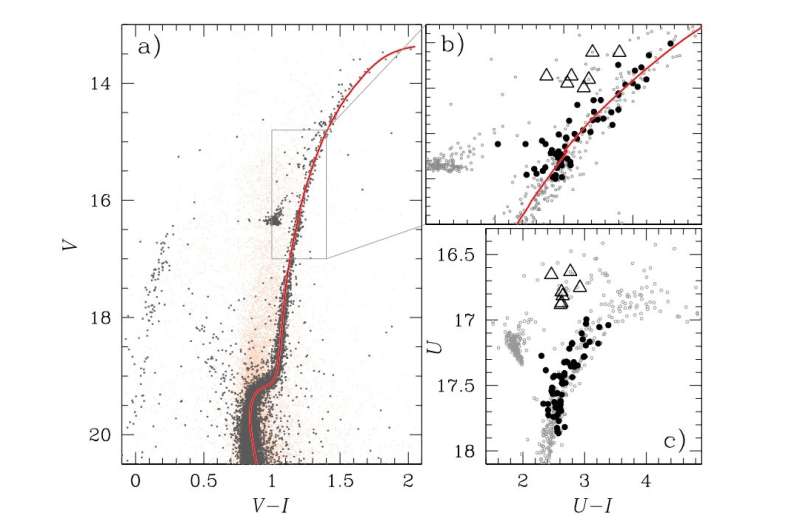Color-magnitude diagrams (CMDs) of stars in the field of view of NGC 2808. Credit: Carlos et al, 2022
Using ESO's Very Large Telescope (VLT) and the Hubble Space Telescope (HST), astronomers have inspected the globular cluster NGC 2808. Results of the study, published December 2 on the arXiv pre-print repository, shed more light on the chemical composition of multiple stellar populations in this cluster.
Globular clusters (GCs) are collections of tightly bound stars orbiting galaxies. Astronomers perceive them as natural laboratories enabling studies on the evolution of stars and galaxies. In particular, globular clusters could help researchers better understand the formation history and evolution of early type galaxies, as the origin of GCs seems to be closely linked to periods of intense star formation.
At a distance of about 31,300 light years, NGC 2808 is a Galactic GC in the constellation Carina. The cluster is estimated to be 10.2 billion years old, has a mass of approximately 742,000 solar masses, and its metallicity is at a level of -1.14. Previous observations of NGC 2808 have found that it hosts at least three stellar populations.
A team of astronomers, led by Marília Gabriela Carlos of the University of Padua in Italy, decided to conduct a full chemical characterization of the distinct stellar populations in NGC 2808. For this purpose they used VLT's FLAMES/GIRAFFE spectrograph, as well as HST's two instruments: the Utraviolet and Visual Channel of the Wide Field Camera 3 (UVIS/WFC3), and the Wide Field Channel of the Advanced Camera for Surveys (WFC/ACS).
Pseudo two-color diagrams or chromosome maps (ChM) of NGC 2808 show that the cluster hosts five different stellar populations (designated from A to E). High-resolution spectra from FLAMES/GIRAFFE allowed the astronomers to investigate 70 red giant branch (RGB) and 7 asymptotic giant branch (AGB) stars. They determined their stellar parameters and abundances for six elements: carbon, nitrogen, oxygen, aluminum, nickel and iron.
In general, the research found that the light elements of the investigated stars vary from one stellar population to another. The maximum internal elemental variations range from about 0.7 dex in carbon, to 1.1 dex in nitrogen, and aluminum, and up to more than 1.3 dex in oxygen. When it comes to the iron peak elements, they show negligible variation between the different populations. These results are typical for multiple stellar populations in the sample of known globular clusters.
Moreover, the study found that the stars from populations A and B have generally lower content of aluminum and nitrogen in contrast with higher abundances of oxygen and carbon. It turned out that while aluminum and nitrogen abundances become gradually higher for populations C and D, reaching their highest values in population E, the abundances of oxygen and carbon become systematically lower. It was added that D and E are the most helium-enriched populations and they do not show significant differences in light elements.
The researchers noted that their observations detected one AGB star, designated N2808_2_9_wf, that is strongly depleted in oxygen (consistent with being helium-rich) and highly enhanced in aluminum, which challenges current stellar evolution models.
"Our discovery, together with previous spectroscopic evidence of an AGB star associated to the population D demonstrates that stars with high helium abundances can evolve into AGB. A similar conclusion comes from the ChMs of AGB stars, which reveals distinct populations of AGB stars that are associated with population D and possibly population E. These findings seem in contrast with the predictions of evolutionary models of the helium-rich stars, which should skip the AGB phase," the authors of the paper explained.
More information: M. Carlos et al, The chemical compositions of multiple stellar populations in the globular cluster NGC 2808, arXiv (2022). DOI: 10.48550/arxiv.2212.01319
Journal information: arXiv
© 2022 Science X Network
























